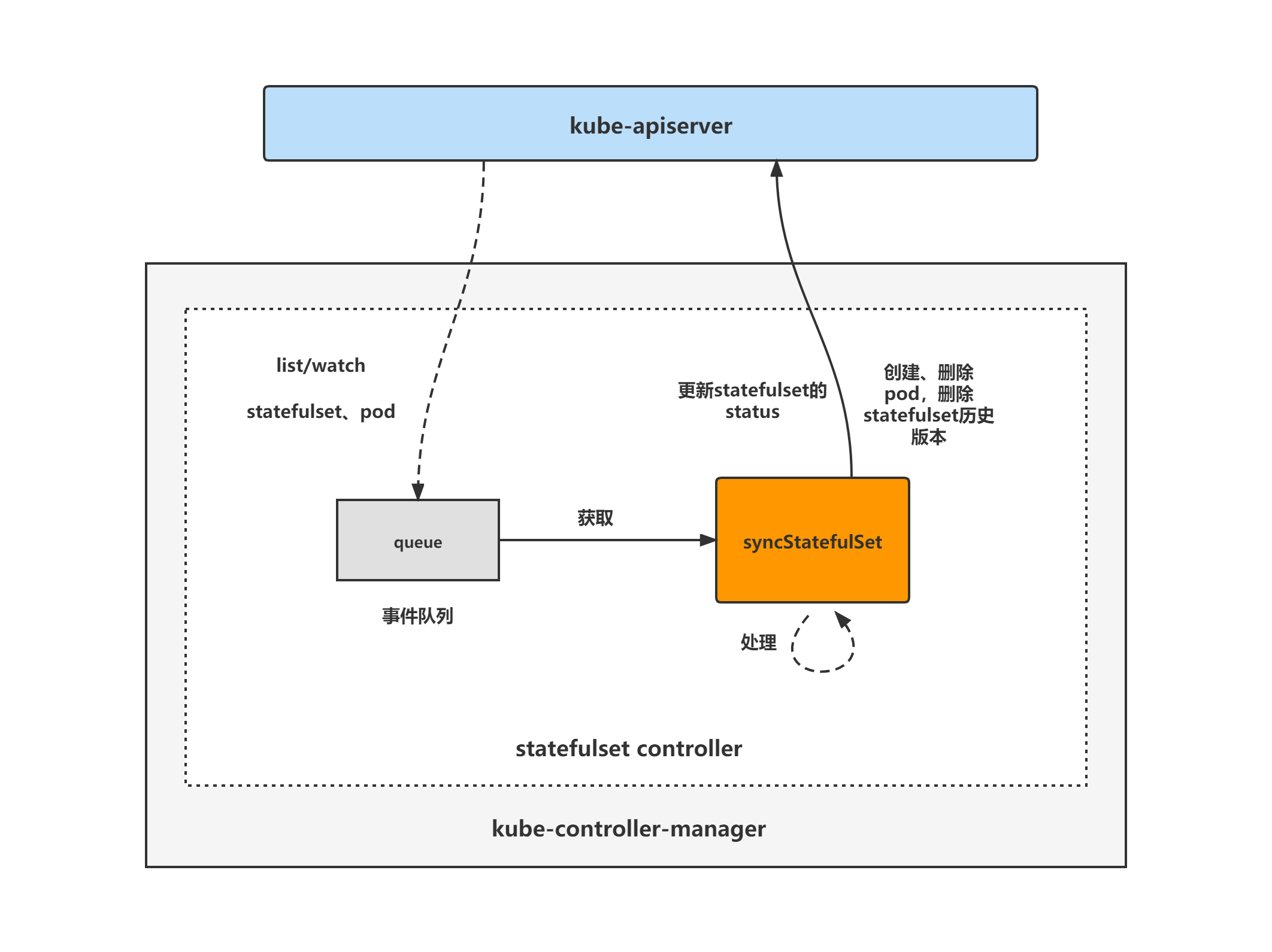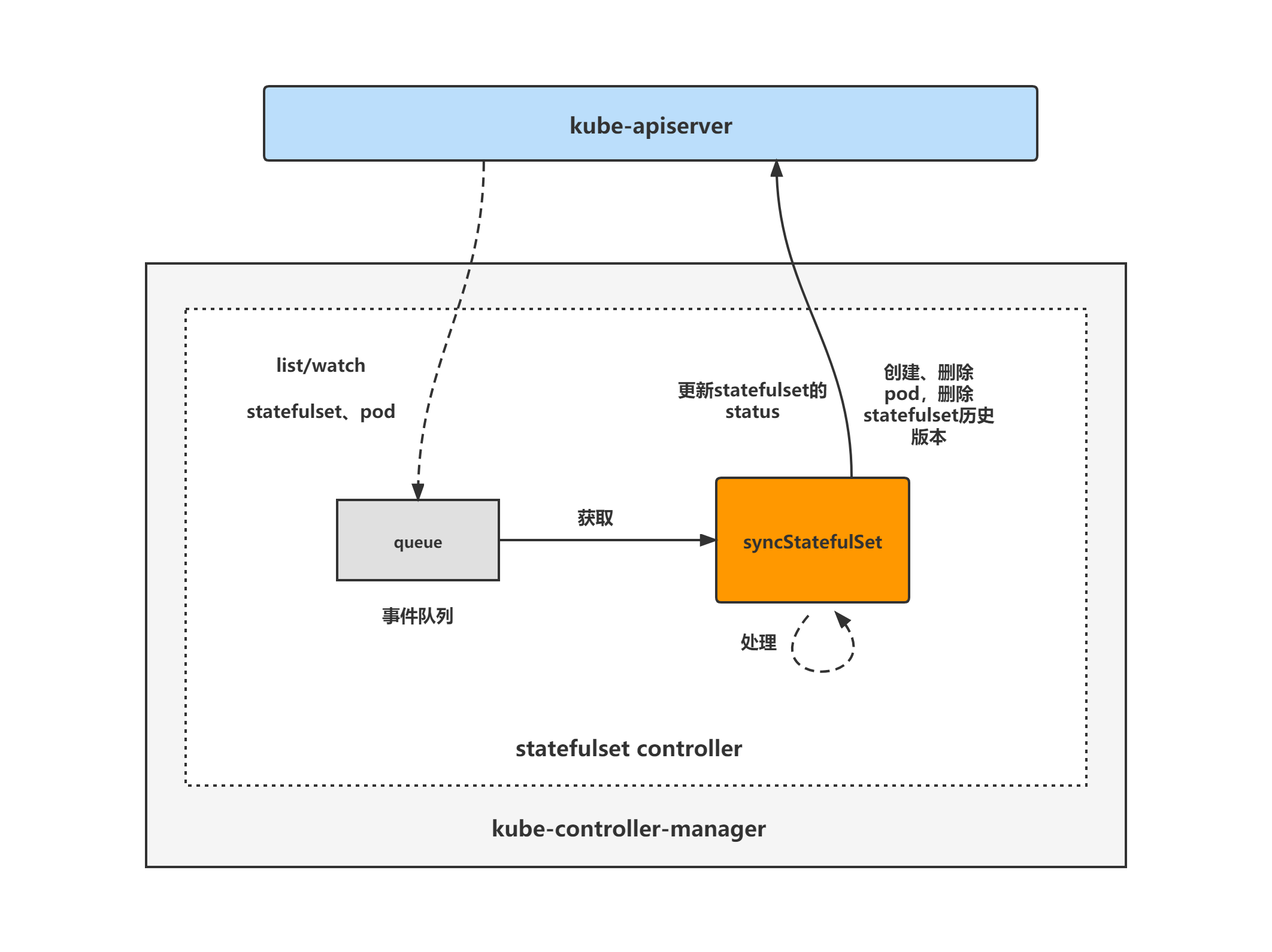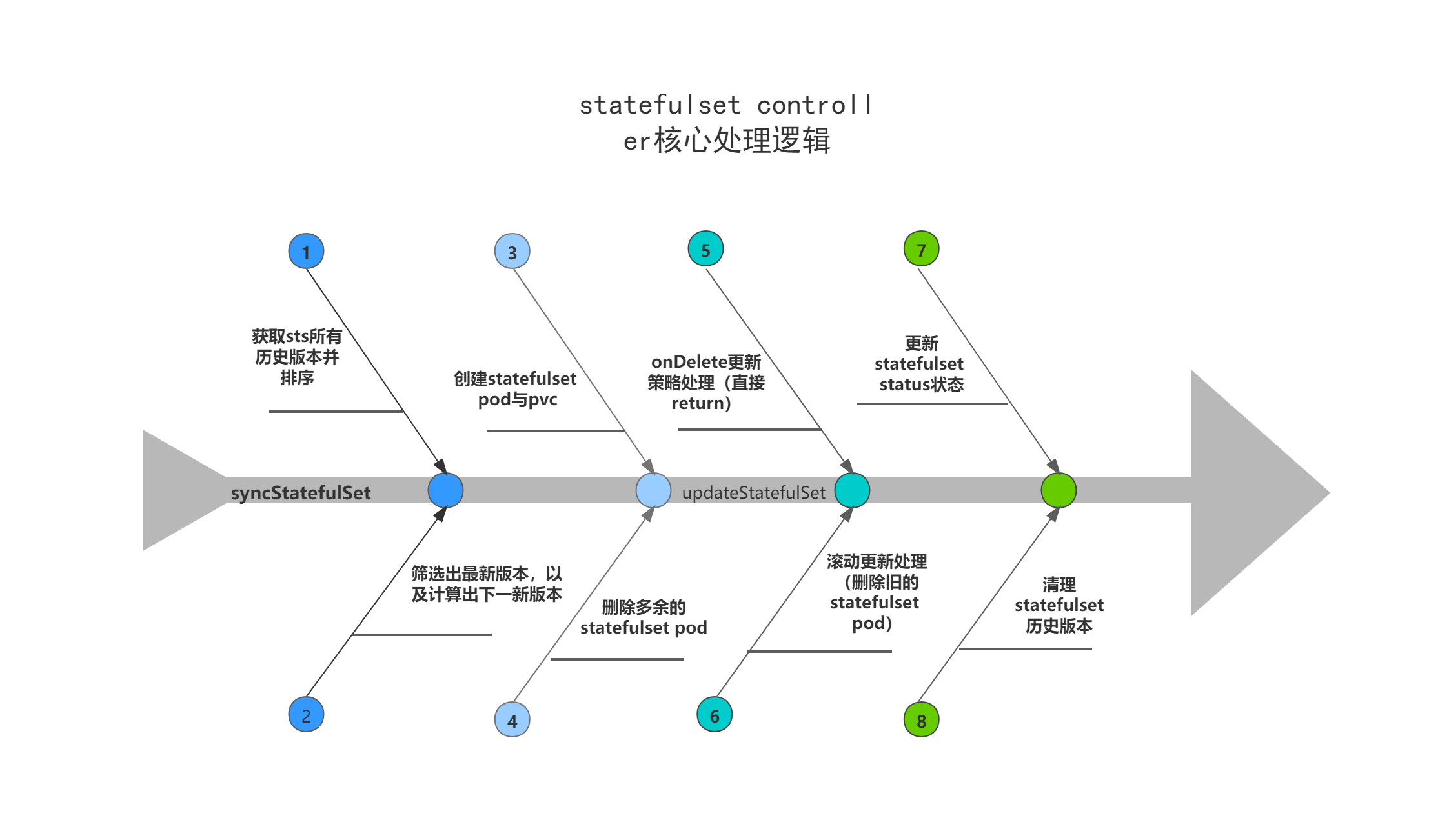k8s statefulset controller源码分析
statefulset controller分析
statefulset简介
statefulset是Kubernetes提供的管理有状态应用的对象,而deployment用于管理无状态应用。
有状态的pod与无状态的pod不一样的是,有状态的pod有时候需要通过其主机名来定位,而无状态的不需要,因为无状态的pod每个都是一样的,随机选一个就行,但对于有状态的来说,每一个pod都不一样,通常希望操作的是特定的某一个。
statefulset适用于需要以下特点的应用:
(1)稳定的网络标志(主机名):Pod重新调度后其PodName和HostName不变;
(2)稳定的持久化存储:基于PVC,Pod重新调度后仍能访问到相同的持久化数据;
(3)稳定的创建与扩容次序:有序创建或扩容,从序号小到大的顺序对pod进行创建(即从0到N-1),且在下一个Pod创建运行之前,所有之前的Pod必须都是Running和Ready状态;
(4)稳定的删除与缩容次序:有序删除或缩容,从序号大到小的顺序对pod进行删除(即从N-1到0),且在下一个Pod终止与删除之前,所有之前的Pod必须都已经被删除;
(5)稳定的滚动更新次序:从序号大到小的顺序对pod进行更新(即从N-1到0),先删除后创建,且需等待当前序号的pod再次创建完成且状态为Ready时才能进行下一个pod的更新处理。
statefulset controller简介
statefulset controller是kube-controller-manager组件中众多控制器中的一个,是 statefulset 资源对象的控制器,其通过对statefulset、pod资源的监听,当资源发生变化时会触发 statefulset controller 对相应的statefulset资源对象进行调谐操作,从而完成statefulset对于pod的创建、删除、更新、扩缩容、statefulset的滚动更新、statefulset状态status更新、旧版本statefulset清理等操作。
statefulset controller架构图
statefulset controller的大致组成和处理流程如下图,statefulset controller对statefulset、pod对象注册了event handler,当有事件时,会watch到然后将对应的statefulset对象放入到queue中,然后syncStatefulSet方法为statefulset controller调谐statefulset对象的核心处理逻辑所在,从queue中取出statefulset对象,做调谐处理。

statefulset pod的命名规则、pod创建与删除
如果创建一个名称为web、replicas为3的statefulset对象,则其pod名称分别为web-0、web-1、web-2。
statefulset pod的创建按0 - n的顺序创建,且在创建下一个pod之前,需要等待前一个pod创建完成并处于ready状态。
同样拿上面的例子来说明,在web statefulset创建后,3 个 Pod 将按顺序创建 web-0,web-1,web-2。在 web-0 处于 ready 状态之前,web-1 将不会被创建,同样当 web-1 处于ready状态之前 web-2也不会被创建。如果在 web-1 ready后,web-2 创建之前, web-0 不处于ready状态了,这个时候 web-2 将不会被创建,直到 web-0 再次回到ready状态。
statefulset滚动更新或缩容过程中pod的删除按n - 0的顺序删除,且在删除下一个pod之前,需要等待前一个pod删除完成。
另外,当statefulset.Spec.VolumeClaimTemplates中定义了pod所需的pvc时,statefulset controller在创建pod时,会同时创建对应的pvc出来,但删除pod时,不会做对应pvc的删除操作,这些pvc需要人工额外做删除操作。
statefulset更新策略
(1)OnDelete:使用 OnDelete 更新策略时,在更新 statefulset pod模板后,只有当你手动删除老的 statefulset pods 之后,新的 statefulset Pod 才会被自动创建。
(2)RollingUpdate:使用 RollingUpdate 更新策略时,在更新 statefulset pod模板后, 老的 statefulset pods 将被删除,并且将根据滚动更新配置自动创建新的 statefulset pods。滚动更新期间,每个序号的statefulset pod最多只能有一个,且滚动更新下一个pod之前,需等待前一个pod更新完成并处于ready状态。与statefulset pod按0 - n的顺序创建不同,滚动更新时Pod按逆序的方式(即n - 0)删除并创建。
statefulset的滚动升级中还有一个Partition配置,在设置partition后,滚动更新过程中,statefulset的Pod中序号大于或等于partition的Pod会进行滚动升级,而其余的Pod保持不变,不会进行滚动更新。
statefulset controller分析将分为两大块进行,分别是:
(1)statefulset controller初始化与启动分析;
(2)statefulset controller处理逻辑分析。
1.statefulset controller初始化与启动分析
基于tag v1.17.4
https://github.com/kubernetes/kubernetes/releases/tag/v1.17.4
直接看到startStatefulSetController函数,作为statefulset controller初始化与启动分析的入口。
startStatefulSetController
startStatefulSetController主要逻辑:
(1)调用statefulset.NewStatefulSetController新建并初始化StatefulSetController;
(2)拉起一个goroutine,跑StatefulSetController的Run方法。
// cmd/kube-controller-manager/app/apps.go
func startStatefulSetController(ctx ControllerContext) (http.Handler, bool, error) {
if !ctx.AvailableResources[schema.GroupVersionResource{Group: "apps", Version: "v1", Resource: "statefulsets"}] {
return nil, false, nil
}
go statefulset.NewStatefulSetController(
ctx.InformerFactory.Core().V1().Pods(),
ctx.InformerFactory.Apps().V1().StatefulSets(),
ctx.InformerFactory.Core().V1().PersistentVolumeClaims(),
ctx.InformerFactory.Apps().V1().ControllerRevisions(),
ctx.ClientBuilder.ClientOrDie("statefulset-controller"),
).Run(int(ctx.ComponentConfig.StatefulSetController.ConcurrentStatefulSetSyncs), ctx.Stop)
return nil, true, nil
}
1.1 statefulset.NewStatefulSetController
从statefulset.NewStatefulSetController函数代码中可以看到,statefulset controller注册了statefulset、pod对象的EventHandler,也即对这几个对象的event进行监听,把event放入事件队列并做处理,对statefulset controller做了初始化。
// pkg/controller/statefulset/stateful_set.go
func NewStatefulSetController(
podInformer coreinformers.PodInformer,
setInformer appsinformers.StatefulSetInformer,
pvcInformer coreinformers.PersistentVolumeClaimInformer,
revInformer appsinformers.ControllerRevisionInformer,
kubeClient clientset.Interface,
) *StatefulSetController {
eventBroadcaster := record.NewBroadcaster()
eventBroadcaster.StartLogging(klog.Infof)
eventBroadcaster.StartRecordingToSink(&v1core.EventSinkImpl{Interface: kubeClient.CoreV1().Events("")})
recorder := eventBroadcaster.NewRecorder(scheme.Scheme, v1.EventSource{Component: "statefulset-controller"})
ssc := &StatefulSetController{
kubeClient: kubeClient,
control: NewDefaultStatefulSetControl(
NewRealStatefulPodControl(
kubeClient,
setInformer.Lister(),
podInformer.Lister(),
pvcInformer.Lister(),
recorder),
NewRealStatefulSetStatusUpdater(kubeClient, setInformer.Lister()),
history.NewHistory(kubeClient, revInformer.Lister()),
recorder,
),
pvcListerSynced: pvcInformer.Informer().HasSynced,
queue: workqueue.NewNamedRateLimitingQueue(workqueue.DefaultControllerRateLimiter(), "statefulset"),
podControl: controller.RealPodControl{KubeClient: kubeClient, Recorder: recorder},
revListerSynced: revInformer.Informer().HasSynced,
}
podInformer.Informer().AddEventHandler(cache.ResourceEventHandlerFuncs{
// lookup the statefulset and enqueue
AddFunc: ssc.addPod,
// lookup current and old statefulset if labels changed
UpdateFunc: ssc.updatePod,
// lookup statefulset accounting for deletion tombstones
DeleteFunc: ssc.deletePod,
})
ssc.podLister = podInformer.Lister()
ssc.podListerSynced = podInformer.Informer().HasSynced
setInformer.Informer().AddEventHandler(
cache.ResourceEventHandlerFuncs{
AddFunc: ssc.enqueueStatefulSet,
UpdateFunc: func(old, cur interface{}) {
oldPS := old.(*apps.StatefulSet)
curPS := cur.(*apps.StatefulSet)
if oldPS.Status.Replicas != curPS.Status.Replicas {
klog.V(4).Infof("Observed updated replica count for StatefulSet: %v, %d->%d", curPS.Name, oldPS.Status.Replicas, curPS.Status.Replicas)
}
ssc.enqueueStatefulSet(cur)
},
DeleteFunc: ssc.enqueueStatefulSet,
},
)
ssc.setLister = setInformer.Lister()
ssc.setListerSynced = setInformer.Informer().HasSynced
// TODO: Watch volumes
return ssc
}
1.2 Run
主要看到for循环处,根据workers的值(可通过kube-controller-manager组件启动参数concurrent-statefulset-syncs来设置,默认值为5),启动相应数量的goroutine,跑ssc.worker方法,调用daemonset controller核心处理方法ssc.sync来调谐statefulset对象。
// pkg/controller/statefulset/stateful_set.go
func (ssc *StatefulSetController) Run(workers int, stopCh <-chan struct{}) {
defer utilruntime.HandleCrash()
defer ssc.queue.ShutDown()
klog.Infof("Starting stateful set controller")
defer klog.Infof("Shutting down statefulset controller")
if !cache.WaitForNamedCacheSync("stateful set", stopCh, ssc.podListerSynced, ssc.setListerSynced, ssc.pvcListerSynced, ssc.revListerSynced) {
return
}
for i := 0; i < workers; i++ {
go wait.Until(ssc.worker, time.Second, stopCh)
}
<-stopCh
}
1.2.1 ssc.worker
从queue队列中取出事件key,并调用ssc.sync(关于ssc.sync方法会在后面做详细分析)对statefulset对象做调谐处理。queue队列里的事件来源前面讲过,是statefulset controller注册的statefulset、pod对象的EventHandler,它们的变化event会被监听到然后放入queue中。
// pkg/controller/daemon/daemon_controller.go
func (ssc *StatefulSetController) worker() {
for ssc.processNextWorkItem() {
}
}
func (ssc *StatefulSetController) processNextWorkItem() bool {
key, quit := ssc.queue.Get()
if quit {
return false
}
defer ssc.queue.Done(key)
if err := ssc.sync(key.(string)); err != nil {
utilruntime.HandleError(fmt.Errorf("Error syncing StatefulSet %v, requeuing: %v", key.(string), err))
ssc.queue.AddRateLimited(key)
} else {
ssc.queue.Forget(key)
}
return true
}
2.statefulset controller核心处理逻辑分析
sync
直接看到statefulset controller核心处理入口sync方法。
主要逻辑:
(1)获取执行方法时的当前时间,并定义defer函数,用于计算该方法总执行时间,也即统计对一个 statefulset 进行同步调谐操作的耗时;
(2)根据 statefulset 对象的命名空间与名称,获取 statefulset 对象;
(3)调用ssc.adoptOrphanRevisions,检查是否有孤儿 controllerrevisions 对象(即.spec.ownerReferences中无controller属性定义或其属性值为false),若有且其与 statefulset 对象的selector匹配 的则添加 ownerReferences 进行关联;
(4)调用ssc.getPodsForStatefulSet,根据 statefulset 对象的selector去查找pod列表,且若有孤儿pod的label与 statefulset 的selector能匹配的则进行关联,若已关联的pod的label不再与statefulset的selector匹配,则更新解除它们的关联关系;
(5)调用ssc.syncStatefulSet,对 statefulset 对象做调谐处理。
// pkg/controller/statefulset/stateful_set.go
func (ssc *StatefulSetController) sync(key string) error {
startTime := time.Now()
defer func() {
klog.V(4).Infof("Finished syncing statefulset %q (%v)", key, time.Since(startTime))
}()
namespace, name, err := cache.SplitMetaNamespaceKey(key)
if err != nil {
return err
}
set, err := ssc.setLister.StatefulSets(namespace).Get(name)
if errors.IsNotFound(err) {
klog.Infof("StatefulSet has been deleted %v", key)
return nil
}
if err != nil {
utilruntime.HandleError(fmt.Errorf("unable to retrieve StatefulSet %v from store: %v", key, err))
return err
}
selector, err := metav1.LabelSelectorAsSelector(set.Spec.Selector)
if err != nil {
utilruntime.HandleError(fmt.Errorf("error converting StatefulSet %v selector: %v", key, err))
// This is a non-transient error, so don't retry.
return nil
}
if err := ssc.adoptOrphanRevisions(set); err != nil {
return err
}
pods, err := ssc.getPodsForStatefulSet(set, selector)
if err != nil {
return err
}
return ssc.syncStatefulSet(set, pods)
}
2.1 ssc.getPodsForStatefulSet
ssc.getPodsForStatefulSet方法主要作用是获取属于 statefulset 对象的pod列表并返回,并检查孤儿pod与已匹配的pod,看是否需要更新statefulset与pod的匹配。
主要逻辑:
(1)获取 statefulset 所在命名空间下的所有pod;
(2)定义过滤出属于 statefulset 对象的pod的函数,即isMemberOf函数(根据pod的名称与statefulset名称匹配来过滤属于statefulset的pod);
(3)调用cm.ClaimPods,过滤出属于该statefulset对象的pod,且若有孤儿pod的label与 statefulset 的selector能匹配的则进行关联,若已关联的pod的label不再与statefulset的selector匹配,则更新解除它们的关联关系。
// pkg/controller/statefulset/stateful_set.go
func (ssc *StatefulSetController) getPodsForStatefulSet(set *apps.StatefulSet, selector labels.Selector) ([]*v1.Pod, error) {
// List all pods to include the pods that don't match the selector anymore but
// has a ControllerRef pointing to this StatefulSet.
pods, err := ssc.podLister.Pods(set.Namespace).List(labels.Everything())
if err != nil {
return nil, err
}
filter := func(pod *v1.Pod) bool {
// Only claim if it matches our StatefulSet name. Otherwise release/ignore.
return isMemberOf(set, pod)
}
// If any adoptions are attempted, we should first recheck for deletion with
// an uncached quorum read sometime after listing Pods (see #42639).
canAdoptFunc := controller.RecheckDeletionTimestamp(func() (metav1.Object, error) {
fresh, err := ssc.kubeClient.AppsV1().StatefulSets(set.Namespace).Get(set.Name, metav1.GetOptions{})
if err != nil {
return nil, err
}
if fresh.UID != set.UID {
return nil, fmt.Errorf("original StatefulSet %v/%v is gone: got uid %v, wanted %v", set.Namespace, set.Name, fresh.UID, set.UID)
}
return fresh, nil
})
cm := controller.NewPodControllerRefManager(ssc.podControl, set, selector, controllerKind, canAdoptFunc)
return cm.ClaimPods(pods, filter)
}
2.2 ssc.syncStatefulSet
ssc.syncStatefulSet方法可以说是statefulset controller的核心处理逻辑所在了,主要看到ssc.control.UpdateStatefulSet方法。
// pkg/controller/statefulset/stateful_set.go
func (ssc *StatefulSetController) syncStatefulSet(set *apps.StatefulSet, pods []*v1.Pod) error {
klog.V(4).Infof("Syncing StatefulSet %v/%v with %d pods", set.Namespace, set.Name, len(pods))
// TODO: investigate where we mutate the set during the update as it is not obvious.
if err := ssc.control.UpdateStatefulSet(set.DeepCopy(), pods); err != nil {
return err
}
klog.V(4).Infof("Successfully synced StatefulSet %s/%s successful", set.Namespace, set.Name)
return nil
}
ssc.control.UpdateStatefulSet方法主要逻辑:
(1)获取statefulset的所有ControllerRevision并根据版本新老顺序排序;
(2)调用ssc.getStatefulSetRevisions,获取现存最新的statefulset版本以及计算出一个新的版本;
(3)调用ssc.updateStatefulSet,完成statefulset对象对于pod的创建、删除、更新、扩缩容等操作;
(4)调用ssc.updateStatefulSetStatus,更新statefulset对象的status状态;
(5)调用ssc.truncateHistory,根据statefulset对象配置的历史版本数量限制,按之前的排序顺序清理掉没有pod的statefulset历史版本。
// pkg/controller/statefulset/stateful_set_control.go
func (ssc *defaultStatefulSetControl) UpdateStatefulSet(set *apps.StatefulSet, pods []*v1.Pod) error {
// list all revisions and sort them
revisions, err := ssc.ListRevisions(set)
if err != nil {
return err
}
history.SortControllerRevisions(revisions)
// get the current, and update revisions
currentRevision, updateRevision, collisionCount, err := ssc.getStatefulSetRevisions(set, revisions)
if err != nil {
return err
}
// perform the main update function and get the status
status, err := ssc.updateStatefulSet(set, currentRevision, updateRevision, collisionCount, pods)
if err != nil {
return err
}
// update the set's status
err = ssc.updateStatefulSetStatus(set, status)
if err != nil {
return err
}
klog.V(4).Infof("StatefulSet %s/%s pod status replicas=%d ready=%d current=%d updated=%d",
set.Namespace,
set.Name,
status.Replicas,
status.ReadyReplicas,
status.CurrentReplicas,
status.UpdatedReplicas)
klog.V(4).Infof("StatefulSet %s/%s revisions current=%s update=%s",
set.Namespace,
set.Name,
status.CurrentRevision,
status.UpdateRevision)
// maintain the set's revision history limit
return ssc.truncateHistory(set, pods, revisions, currentRevision, updateRevision)
}
2.2.1 ssc.updateStatefulSet
updateStatefulSet方法是statefulset对象调谐操作中的核心方法,完成statefulset对象对于pod的创建、删除、更新、扩缩容等操作。此方法代码比较长,跟随我的节奏慢慢分析。
主要逻辑:
(1)看到第一个for循环,将statefulset的所有pod按ord(ord即为pod name中的序号)的值分到replicas和condemned两个数组中,序号小于statefulset对象期望副本数值的放到replicas数组(因为序号从0开始,所以是小于期望副本数值),大于等于期望副本数值的放到condemned数组,replicas数组代表正常的可用的pod列表,condemned数组中的是需要被删除的pod列表;在遍历pod时,同时根据pod的状态计算statefulset对象的status值;
(2)第二个for循环,当序号小于statefulset期望副本数值的pod未创建出来时,则根据statefulset对象中的pod模板,构建出相应序号值的pod对象(此时还并没有向apiserver发起创建pod的请求,只是构建好pod结构体);
(3)第三个和第四个for循环,遍历replicas和condemned两个数组,找到非healthy状态的最小序号的pod记录下来,并记录序号;
(4)当statefulset对象的DeletionTimestamp不为nil时,直接返回前面计算出来的statefulset的新status值,不再进行方法后续的逻辑处理;
(5)获取monotonic的值,当statefulset.Spec.PodManagementPolicy的值为Parallel时,monotonic的值为false,否则为true(Parallel代表statefulset controller可以并行的处理同一statefulset的pod,串行则代表在启动和终止下一个pod之前需要等待前一个pod变成ready状态或pod对象被删除掉);
(6)第五个for循环,遍历replicas数组,处理statefulset的pod,主要是做pod的创建(包括根据statefulset.Spec.VolumeClaimTemplates中定义的pod所需的pvc的创建):
(6.1)当pod处于fail状态(pod.Status.Phase的值为Failed)时,调用apiserver删除该pod(pod对应的pvc在这里不会做删除操作)并给replicas数组构建相应序号的新的pod结构体(用于下一步中重新创建该序号的pod);
(6.2)如果相应序号的pod未创建时,调用apiserver创建该序号的pod(包括创建pvc),且当monotonic为true时(statefulset没有配置Parallel),直接return,结束updateStatefulSet方法的执行;
(6.3)剩下的逻辑就是当没有配置Parallel时,将串行处理pod,在启动和终止下一个pod之前需要等待前一个pod变成ready状态或pod对象被删除掉,不再展开分析;
(7)第六个for循环,逆序(pod序号从大到小)遍历condemned数组,处理statefulset的pod,主要是做多余pod的删除,删除逻辑也受Parallel影响,不展开分析。
(8)判断statefulset的更新策略,若为OnDelete,则直接return(使用了该更新策略,则需要人工删除pod后才会重建相应序号的pod);
(9)获取滚动更新配置中的Partition值,当statefulset进行滚动更新时,小于等于该序号的pod将不会被更新;
(10)第七个for循环,主要是处理更新策略为RollingUpdate的statefulset对象的更新。statefulset的滚动更新,从序号大到小的顺序对pod进行更新,先删除后创建,且需等待当前序号的pod再次创建完成且状态为Ready时才能进行下一个pod的更新处理。
// pkg/controller/statefulset/stateful_set_control.go
func (ssc *defaultStatefulSetControl) updateStatefulSet(
set *apps.StatefulSet,
currentRevision *apps.ControllerRevision,
updateRevision *apps.ControllerRevision,
collisionCount int32,
pods []*v1.Pod) (*apps.StatefulSetStatus, error) {
// get the current and update revisions of the set.
currentSet, err := ApplyRevision(set, currentRevision)
if err != nil {
return nil, err
}
updateSet, err := ApplyRevision(set, updateRevision)
if err != nil {
return nil, err
}
// set the generation, and revisions in the returned status
status := apps.StatefulSetStatus{}
status.ObservedGeneration = set.Generation
status.CurrentRevision = currentRevision.Name
status.UpdateRevision = updateRevision.Name
status.CollisionCount = new(int32)
*status.CollisionCount = collisionCount
replicaCount := int(*set.Spec.Replicas)
// slice that will contain all Pods such that 0 <= getOrdinal(pod) < set.Spec.Replicas
replicas := make([]*v1.Pod, replicaCount)
// slice that will contain all Pods such that set.Spec.Replicas <= getOrdinal(pod)
condemned := make([]*v1.Pod, 0, len(pods))
unhealthy := 0
firstUnhealthyOrdinal := math.MaxInt32
var firstUnhealthyPod *v1.Pod
// 第一个for循环,将statefulset的pod分到replicas和condemned两个数组中,其中condemned数组中的pod代表需要被删除的
// First we partition pods into two lists valid replicas and condemned Pods
for i := range pods {
status.Replicas++
// count the number of running and ready replicas
if isRunningAndReady(pods[i]) {
status.ReadyReplicas++
}
// count the number of current and update replicas
if isCreated(pods[i]) && !isTerminating(pods[i]) {
if getPodRevision(pods[i]) == currentRevision.Name {
status.CurrentReplicas++
}
if getPodRevision(pods[i]) == updateRevision.Name {
status.UpdatedReplicas++
}
}
if ord := getOrdinal(pods[i]); 0 <= ord && ord < replicaCount {
// if the ordinal of the pod is within the range of the current number of replicas,
// insert it at the indirection of its ordinal
replicas[ord] = pods[i]
} else if ord >= replicaCount {
// if the ordinal is greater than the number of replicas add it to the condemned list
condemned = append(condemned, pods[i])
}
// If the ordinal could not be parsed (ord < 0), ignore the Pod.
}
// 第二个for循环,当序号小于statefulset期望副本数值的pod未创建出来时,则根据statefulset对象中的pod模板,构建出相应序号值的pod对象(此时还并没有向apiserver发起创建pod的请求,只是构建好pod结构体)
// for any empty indices in the sequence [0,set.Spec.Replicas) create a new Pod at the correct revision
for ord := 0; ord < replicaCount; ord++ {
if replicas[ord] == nil {
replicas[ord] = newVersionedStatefulSetPod(
currentSet,
updateSet,
currentRevision.Name,
updateRevision.Name, ord)
}
}
// sort the condemned Pods by their ordinals
sort.Sort(ascendingOrdinal(condemned))
// 第三个和第四个for循环,遍历replicas和condemned两个数组,找到非healthy状态的最小序号的pod记录下来,并记录序号
// find the first unhealthy Pod
for i := range replicas {
if !isHealthy(replicas[i]) {
unhealthy++
if ord := getOrdinal(replicas[i]); ord < firstUnhealthyOrdinal {
firstUnhealthyOrdinal = ord
firstUnhealthyPod = replicas[i]
}
}
}
for i := range condemned {
if !isHealthy(condemned[i]) {
unhealthy++
if ord := getOrdinal(condemned[i]); ord < firstUnhealthyOrdinal {
firstUnhealthyOrdinal = ord
firstUnhealthyPod = condemned[i]
}
}
}
if unhealthy > 0 {
klog.V(4).Infof("StatefulSet %s/%s has %d unhealthy Pods starting with %s",
set.Namespace,
set.Name,
unhealthy,
firstUnhealthyPod.Name)
}
// 当statefulset对象的DeletionTimestamp不为nil时,直接返回前面计算出来的statefulset的新status值,不再进行方法后续的逻辑处理
// If the StatefulSet is being deleted, don't do anything other than updating
// status.
if set.DeletionTimestamp != nil {
return &status, nil
}
// 获取monotonic的值,当statefulset.Spec.PodManagementPolicy的值为Parallel时,monotonic的值为false,否则为true
monotonic := !allowsBurst(set)
// 第五个for循环,遍历replicas数组,处理statefulset的pod,主要是做pod的创建
// Examine each replica with respect to its ordinal
for i := range replicas {
// delete and recreate failed pods
if isFailed(replicas[i]) {
ssc.recorder.Eventf(set, v1.EventTypeWarning, "RecreatingFailedPod",
"StatefulSet %s/%s is recreating failed Pod %s",
set.Namespace,
set.Name,
replicas[i].Name)
if err := ssc.podControl.DeleteStatefulPod(set, replicas[i]); err != nil {
return &status, err
}
if getPodRevision(replicas[i]) == currentRevision.Name {
status.CurrentReplicas--
}
if getPodRevision(replicas[i]) == updateRevision.Name {
status.UpdatedReplicas--
}
status.Replicas--
replicas[i] = newVersionedStatefulSetPod(
currentSet,
updateSet,
currentRevision.Name,
updateRevision.Name,
i)
}
// If we find a Pod that has not been created we create the Pod
if !isCreated(replicas[i]) {
if err := ssc.podControl.CreateStatefulPod(set, replicas[i]); err != nil {
return &status, err
}
status.Replicas++
if getPodRevision(replicas[i]) == currentRevision.Name {
status.CurrentReplicas++
}
if getPodRevision(replicas[i]) == updateRevision.Name {
status.UpdatedReplicas++
}
// if the set does not allow bursting, return immediately
if monotonic {
return &status, nil
}
// pod created, no more work possible for this round
continue
}
// If we find a Pod that is currently terminating, we must wait until graceful deletion
// completes before we continue to make progress.
if isTerminating(replicas[i]) && monotonic {
klog.V(4).Infof(
"StatefulSet %s/%s is waiting for Pod %s to Terminate",
set.Namespace,
set.Name,
replicas[i].Name)
return &status, nil
}
// If we have a Pod that has been created but is not running and ready we can not make progress.
// We must ensure that all for each Pod, when we create it, all of its predecessors, with respect to its
// ordinal, are Running and Ready.
if !isRunningAndReady(replicas[i]) && monotonic {
klog.V(4).Infof(
"StatefulSet %s/%s is waiting for Pod %s to be Running and Ready",
set.Namespace,
set.Name,
replicas[i].Name)
return &status, nil
}
// Enforce the StatefulSet invariants
if identityMatches(set, replicas[i]) && storageMatches(set, replicas[i]) {
continue
}
// Make a deep copy so we don't mutate the shared cache
replica := replicas[i].DeepCopy()
if err := ssc.podControl.UpdateStatefulPod(updateSet, replica); err != nil {
return &status, err
}
}
// 第六个for循环,逆序(pod序号从大到小)遍历condemned数组,处理statefulset的pod,主要是做多余pod的删除
// At this point, all of the current Replicas are Running and Ready, we can consider termination.
// We will wait for all predecessors to be Running and Ready prior to attempting a deletion.
// We will terminate Pods in a monotonically decreasing order over [len(pods),set.Spec.Replicas).
// Note that we do not resurrect Pods in this interval. Also note that scaling will take precedence over
// updates.
for target := len(condemned) - 1; target >= 0; target-- {
// wait for terminating pods to expire
if isTerminating(condemned[target]) {
klog.V(4).Infof(
"StatefulSet %s/%s is waiting for Pod %s to Terminate prior to scale down",
set.Namespace,
set.Name,
condemned[target].Name)
// block if we are in monotonic mode
if monotonic {
return &status, nil
}
continue
}
// if we are in monotonic mode and the condemned target is not the first unhealthy Pod block
if !isRunningAndReady(condemned[target]) && monotonic && condemned[target] != firstUnhealthyPod {
klog.V(4).Infof(
"StatefulSet %s/%s is waiting for Pod %s to be Running and Ready prior to scale down",
set.Namespace,
set.Name,
firstUnhealthyPod.Name)
return &status, nil
}
klog.V(2).Infof("StatefulSet %s/%s terminating Pod %s for scale down",
set.Namespace,
set.Name,
condemned[target].Name)
if err := ssc.podControl.DeleteStatefulPod(set, condemned[target]); err != nil {
return &status, err
}
if getPodRevision(condemned[target]) == currentRevision.Name {
status.CurrentReplicas--
}
if getPodRevision(condemned[target]) == updateRevision.Name {
status.UpdatedReplicas--
}
if monotonic {
return &status, nil
}
}
// 判断statefulset的更新策略,若为OnDelete,则直接return(使用了该更新策略,则需要人工删除pod后才会重建相应序号的pod)
// for the OnDelete strategy we short circuit. Pods will be updated when they are manually deleted.
if set.Spec.UpdateStrategy.Type == apps.OnDeleteStatefulSetStrategyType {
return &status, nil
}
// 获取滚动更新配置中的Partition值,当statefulset进行滚动更新时,小于等于该序号的pod将不会被更新
// we compute the minimum ordinal of the target sequence for a destructive update based on the strategy.
updateMin := 0
if set.Spec.UpdateStrategy.RollingUpdate != nil {
updateMin = int(*set.Spec.UpdateStrategy.RollingUpdate.Partition)
}
// 第七个for循环,主要是处理更新策略为RollingUpdate的statefulset对象的更新
// we terminate the Pod with the largest ordinal that does not match the update revision.
for target := len(replicas) - 1; target >= updateMin; target-- {
// delete the Pod if it is not already terminating and does not match the update revision.
if getPodRevision(replicas[target]) != updateRevision.Name && !isTerminating(replicas[target]) {
klog.V(2).Infof("StatefulSet %s/%s terminating Pod %s for update",
set.Namespace,
set.Name,
replicas[target].Name)
err := ssc.podControl.DeleteStatefulPod(set, replicas[target])
status.CurrentReplicas--
return &status, err
}
// wait for unhealthy Pods on update
if !isHealthy(replicas[target]) {
klog.V(4).Infof(
"StatefulSet %s/%s is waiting for Pod %s to update",
set.Namespace,
set.Name,
replicas[target].Name)
return &status, nil
}
}
return &status, nil
}
结合上面对该方法的分析,来总结下在此方法中都有哪些步骤涉及了statefulset对象对于pod的创建、删除、扩缩容、更新操作:
1.创建:主要是(6)第五个for循环;
2.删除:主要是(7)第六个for循环;
3.扩缩容: (1)~(7);
4.更新:主要是(8)(9)与(10)第七个for循环,其中(8)为OnDelete更新策略的处理,(9)(10)为滚动更新策略的处理。
总结
statefulset controller架构图
statefulset controller的大致组成和处理流程如下图,statefulset controller对statefulset、pod对象注册了event handler,当有事件时,会watch到然后将对应的statefulset对象放入到queue中,然后syncStatefulSet方法为statefulset controller调谐statefulset对象的核心处理逻辑所在,从queue中取出statefulset对象,做调谐处理。

statefulset controller核心处理逻辑
statefulset controller的核心处理逻辑是调谐statefulset对象,从而完成statefulset对于pod的创建、删除、更新、扩缩容、statefulset的滚动更新、statefulset状态status更新、旧版本statefulset清理等操作。

statefulset更新策略
(1)OnDelete:使用 OnDelete 更新策略时,在更新 statefulset pod模板后,只有当你手动删除老的 statefulset pods 之后,新的 statefulset Pod 才会被自动创建。
(2)RollingUpdate:使用 RollingUpdate 更新策略时,在更新 statefulset pod模板后, 老的 statefulset pods 将被删除,并且将根据滚动更新配置自动创建新的 statefulset pods。滚动更新期间,每个序号的statefulset pod最多只能有一个,且滚动更新下一个pod之前,需等待前一个pod更新完成并处于ready状态。与statefulset pod按0 - n的顺序创建不同,滚动更新时Pod按逆序的方式(即n - 0)删除并创建。
statefulset的滚动升级中还有一个Partition配置,在设置partition后,滚动更新过程中,statefulset的Pod中序号大于或等于partition的Pod会进行滚动升级,而其余的Pod保持不变,不会进行滚动更新。
statefulset pod的命名规则、pod创建与删除
如果创建一个名称为web、replicas为3的statefulset对象,则其pod名称分别为web-0、web-1、web-2。
statefulset pod的创建按0 - n的顺序创建,且在创建下一个pod之前,需要等待前一个pod创建完成并处于ready状态。
同样拿上面的例子来说明,在web statefulset创建后,3 个 Pod 将按顺序创建 web-0,web-1,web-2。在 web-0 处于 ready 状态之前,web-1 将不会被创建,同样当 web-1 处于ready状态之前 web-2也不会被创建。如果在 web-1 ready后,web-2 创建之前, web-0 不处于ready状态了,这个时候 web-2 将不会被创建,直到 web-0 再次回到ready状态。
statefulset滚动更新或缩容过程中pod的删除按n - 0的顺序删除,且在删除下一个pod之前,需要等待前一个pod删除完成。
另外,当statefulset.Spec.VolumeClaimTemplates中定义了pod所需的pvc时,statefulset controller在创建pod时,会同时创建对应的pvc出来,但删除pod时,不会做对应pvc的删除操作,这些pvc需要人工额外做删除操作。
k8s statefulset controller源码分析的更多相关文章
- k8s deployment controller源码分析
deployment controller简介 deployment controller是kube-controller-manager组件中众多控制器中的一个,是 deployment 资源对象的 ...
- k8s daemonset controller源码分析
daemonset controller分析 daemonset controller简介 daemonset controller是kube-controller-manager组件中众多控制器中的 ...
- kubernetes垃圾回收器GarbageCollector Controller源码分析(二)
kubernetes版本:1.13.2 接上一节:kubernetes垃圾回收器GarbageCollector Controller源码分析(一) 主要步骤 GarbageCollector Con ...
- Spring之SpringMVC的Controller(源码)分析
说明: 例子就不举了,还是直接进入主题,本文主要是以SpringMVC的Controller接口为入点,来分析SpringMVC中C的具体实现和处理过程. 1.Controller接口 public ...
- Kubernetes Deployment 源码分析(二)
概述startDeploymentController 入口逻辑DeploymentController 对象DeploymentController 类型定义DeploymentController ...
- k8s client-go源码分析 informer源码分析(5)-Controller&Processor源码分析
client-go之Controller&Processor源码分析 1.controller与Processor概述 Controller Controller从DeltaFIFO中pop ...
- 《k8s 源码分析》- Custom Controller 之 Informer
Custom Controller 之 Informer 概述 架构概览 reflector - List & Watch API Server Reflector 对象 ListAndWat ...
- 7.深入k8s:任务调用Job与CronJob及源码分析
转载请声明出处哦~,本篇文章发布于luozhiyun的博客:https://www.luozhiyun.com 在使用job中,我会结合源码进行一定的讲解,我们也可以从源码中一窥究竟,一些细节k8s是 ...
- 11.深入k8s:kubelet工作原理及源码分析
转载请声明出处哦~,本篇文章发布于luozhiyun的博客:https://www.luozhiyun.com 源码版本是1.19 kubelet信息量是很大的,通过我这一篇文章肯定是讲不全的,大家可 ...
随机推荐
- nginx源码编译安装(详解)
nginx编译安装 安装步骤: 官网下载合适的版本,建议选择稳定版本. 官网地址:https://nginx.org wget https://nginx.org/download/nginx-1.2 ...
- C 函数指针 函数指针数组 转移表
内容来自<c和指针>,整理后方便个人理解 高级声明 cdel程序可以方便的给出声明的释义 指向函数的指针 int ( *f ) ( int n_values, float amount ) ...
- 一个简单的单例模式Demo
/** * @author :nx014924 * @date :Created in 5/30/2021 1:09 PM * @description: * @modified By: * @ver ...
- 梦开始的地方(Noip模拟3) 2021.5.24
T1 景区路线规划(期望dp/记忆化搜索) 一看题目发现肯定是概率期望题,再仔细想想这三天做的题,就知道是个期望dp. 考试思路(错): 因为聪聪与可可的10分打法根深蒂固,导致在考试时想到了用深搜( ...
- python的random模块生成随机数
python的random函数 random.random() 生成0-1之间的随机数 random.uniform(a,b)生成a,b之间的浮点数 random.randint(a,b)生成a,b之 ...
- Linux线程互斥学习笔记--详细分析
一.互斥锁 为啥要有互斥? 多个进程/线程执行的先后顺序不确定,何时切出CPU也不确定. 多个进程/线程访问变量的动作往往不是原子的. 1. 操作步骤 (1)创建锁 // 创建互斥锁mutex pth ...
- SVN查看项目修改记录及修改内容
工具/原料 svn 一,查看修改记录 1 选择要查看的文件夹,打开之后在空白的地方右键. 2 选择svn里面的"查看日志".show_Log 3 在弹出的日志框里,可以看到,你可以 ...
- Python pylint requires Python '>=3.4.*' but the running Python is 2.7.12
用pylint 1.9.x 安装 pip install pylint==1.9.3. 或者换源 pip install -i https://pypi.tuna.tsinghua.edu.cn/si ...
- Ubuntu中python的mysql操作
1.在已经安装了python和MySQL数据库的前提下使用pip3 install PyMySQL命令 2. 建立链接: (1)首先使用命令python 进入编程模式,再导入包: import pym ...
- Redis去重方法
目录 1.基于 set 2.基于 bit 3.基于 HyperLogLog 4. 基于bloomfilter 这篇文章主要介绍了Redis实现唯一计数的3种方法分享,本文讲解了基于SET.基于 bit ...
